Meindert Hobbema facts for kids
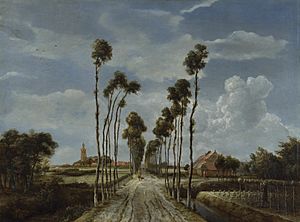
Meindert Hobbema (born October 31, 1638 – died December 7, 1709) was a famous Dutch Golden Age painter. He mostly painted landscapes, especially scenes with forests. However, his most well-known painting, The Avenue at Middelharnis (1689), shows a different kind of scene.
Hobbema learned to paint from Jacob van Ruisdael, who was a very important landscape painter at that time. Hobbema became known for his "sunny forest scenes." These often showed roads, shiny ponds, and groups of trees. He also painted over 30 pictures featuring water mills.
Most of his best paintings were made in the 1660s. After he got married and started a job collecting taxes in 1668, he painted much less. After 1689, he seemed to stop painting completely. Hobbema was not very famous during his lifetime. But his art became very popular from the late 1700s until the 1900s.
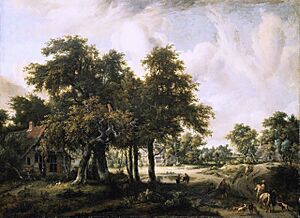
Contents
Hobbema's Early Life and Training
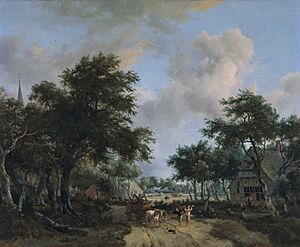
Meindert Hobbema was born and died in Amsterdam, Netherlands. His father was a carpenter named Lubbert Meyndertsz. Meindert took his grandmother's last name, Hobbema, early in his life. We don't know why he did this.
Around 1655, Hobbema became the only known student of Jacob van Ruisdael. Ruisdael was a leading landscape artist in Amsterdam. Ruisdael's style had a big impact on Hobbema's own paintings. Another artist, Jan van Kessel, was also close to Hobbema. Hobbema was even the godfather to one of van Kessel's children in 1675.
Hobbema signed his paintings between 1658 and 1689. Sometimes, people would try to sell Hobbema's paintings as if they were by Ruisdael. This was because Ruisdael was more famous. So, Hobbema's name was probably removed from some of his works. Hobbema also painted the people in some of Ruisdael's paintings. Ruisdael was not as good at painting figures.
Marriage and Later Career

Hobbema married Eeltje Vinck when he was 30 years old. She was a maidservant for a powerful politician named Lambert Reynst. They got married on November 2, 1668, in the Oude Kerk (Old Church) in Amsterdam. Jacob van Ruisdael was one of the witnesses at their wedding.
Meindert and Eeltje had five children together. Eeltje passed away in 1704. Hobbema himself died in December 1709. Both were buried in the poor sections of cemeteries in Amsterdam.
Also in 1668, Hobbema got a good job as a "wine-gauger." This meant he measured wine and collected local taxes on it in Amsterdam. He kept this job until he died. After starting this job, he painted much less. However, he did not stop painting completely, as some people used to think. The quality of his later work varied. But he still created some very successful paintings, like The Avenue at Middelharnis, which is from 1689.
After 1672, the art market in the Netherlands became very difficult. Many artists, including Hobbema, Johannes Vermeer, and Pieter de Hooch, painted much less during this time. Hobbema's family lived in the Rozengracht area of Amsterdam. Many other artists, like Rembrandt, also lived there. Hobbema, Rembrandt, and Ruisdael all died without much money. This happened after their art styles became less popular and the art market struggled.
Hobbema and Ruisdael are seen as the last major landscape artists of the Dutch Golden Age. By the end of Hobbema's career, there was much less demand for art.
Hobbema's Painting Style
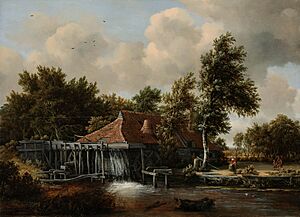
Even though Hobbema learned from Jacob van Ruisdael, his first paintings were river scenes. These were more like the style of artists such as Cornelis Vroom. Around 1662, Ruisdael's influence became much stronger. Hobbema then focused on painting wooded landscapes. These often included ponds, roads, and a building or two. Even for his time, Hobbema focused very closely on this specific type of scene.
Most of his best works were created in the 1660s, especially before 1668. His paintings became larger and more detailed as he improved his style. Hobbema's landscapes often look sunnier than Ruisdael's. He was very good at showing different effects of light and color in his art. He sometimes used two vanishing points to make his compositions more interesting. Some of his paintings from 1664 were almost exact copies of Ruisdael's work. He also often painted the same scenes with small changes.
His paintings usually show paths or roads winding through thick trees and plants. The trees vary in size and spread out. Watermills and other buildings are usually seen a little further away. He typically included only one or two buildings in each picture. His compositions were carefully planned and likely imaginary. He usually avoided making things look perfectly even or symmetrical.
The Avenue at Middelharnis is a very late painting by Hobbema. It is different from his usual forest scenes. This painting shows a real place very accurately. Instead of wild woods, it shows straight lines, trimmed trees, and deep ditches. These details highlight that humans shaped this landscape. There is a small area of wild woods on the left. This contrasts with the young trees planted in rows on the right. It's also unusual for a 17th-century Dutch landscape to show someone working the land.
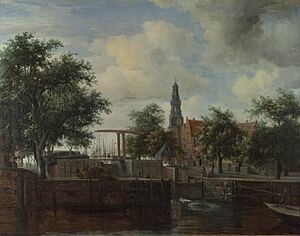
The Haarlem Lock, Amsterdam in the National Gallery is his only painting of a town that is widely accepted as his work. Even in this painting, the front part of the scene is mostly trees and water. The street corner where Hobbema lived in 1668 can be seen on the left. Sometimes, Hobbema had other artists, like Adriaen van de Velde, paint the people in his pictures. This was a common practice at the time. He might have also hired others to paint birds and animals.
Hobbema often painted on oak wood panels, at least until the late 1660s. We don't have any drawings that are definitely by him. It is thought that he created his paintings in his studio. He probably used sketches he made earlier to put different parts of the scene together.
Hobbema's Reputation and Legacy
Hobbema was not mentioned by Arnold Houbraken, who wrote about Dutch Golden Age artists. In fact, no one wrote about Hobbema during his lifetime. His paintings rarely appeared in early art sales, and when they did, they sold for very little. People in England, and to some extent France, liked his work more than people in the Netherlands in the 1700s. Many of his paintings were bought and taken out of Holland.
His painting style became well-known and respected during the Romantic period. The value of his paintings began to rise, especially in England. Artists like John Constable and John Crome admired him. He influenced the Norwich School of painters.
By the 1820s, Hobbema's paintings could sell for over £1,000. By 1900, prices went over £10,000. A record price of £33,000 was reached in 1933 for a painting sold to America. More recently, a painting now in the Mauritshuis sold for £3.74 million in 1995. Another large painting, now in the J. Paul Getty Museum, sold for £6.5 million in 2001.
Today, art experts have mixed feelings about Hobbema's work. Some find his forest scenes a bit boring. Others appreciate them more. However, The Avenue at Middelharnis is almost universally loved. Many see it as a unique masterpiece. As one art historian said, "it is as if the artist had produced only a single picture."
Other Facts
- In 1891, a small town in Alberta, Canada, was named Hobbema after the painter. On January 1, 2014, the name was changed to Maskwacis. This means "Bear Hills" in the language of the native Cree people who live there.
See also
 In Spanish: Meindert Hobbema para niños
In Spanish: Meindert Hobbema para niños

